Strategic Challenges Faced by SMEs in Tobago Cottage Industry
VerifiedAdded on 2021/04/17
|20
|4353
|74
Project
AI Summary
This project report investigates the strategic challenges encountered by Small and Medium Enterprises (SMEs) within the cottage industry in Tobago. The research begins with an introduction outlining the background, problem definition, rationale, research question, aims, and objectives. Chapter 2 provides a literature review, defining SMEs, discussing their contribution to economic development, and analyzing the specific strategic challenges faced by the cottage industry in Tobago, such as lack of credit, high transportation costs, old machinery, insufficient skilled labor, undeveloped markets, and scattered distribution. The chapter also proposes solutions to these challenges, including developing market identity, product promotion, establishing market infrastructure, e-marketing, and improving transportation linkages. Chapter 3 details the research design and methodology, including the research paradigm, methodology, data collection methods (questionnaires and interviews), sampling method, data analysis techniques, ethical considerations, limitations, and a research timetable and project plan. The study uses a positivistic paradigm and a quantitative data analysis approach to examine the challenges and propose potential solutions for SME development in Tobago's cottage industry.
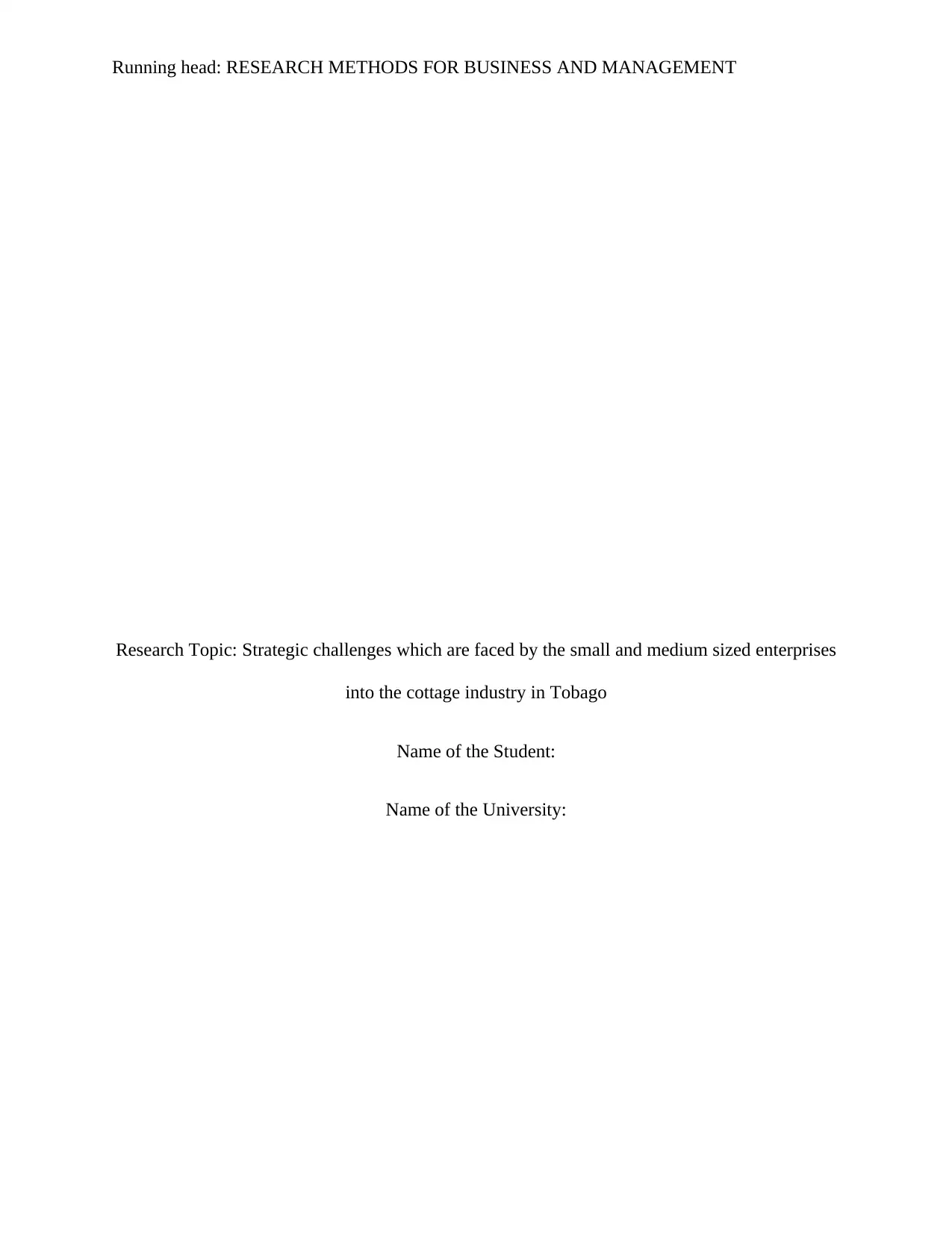
Running head: RESEARCH METHODS FOR BUSINESS AND MANAGEMENT
Research Topic: Strategic challenges which are faced by the small and medium sized enterprises
into the cottage industry in Tobago
Name of the Student:
Name of the University:
Research Topic: Strategic challenges which are faced by the small and medium sized enterprises
into the cottage industry in Tobago
Name of the Student:
Name of the University:
Paraphrase This Document
Need a fresh take? Get an instant paraphrase of this document with our AI Paraphraser
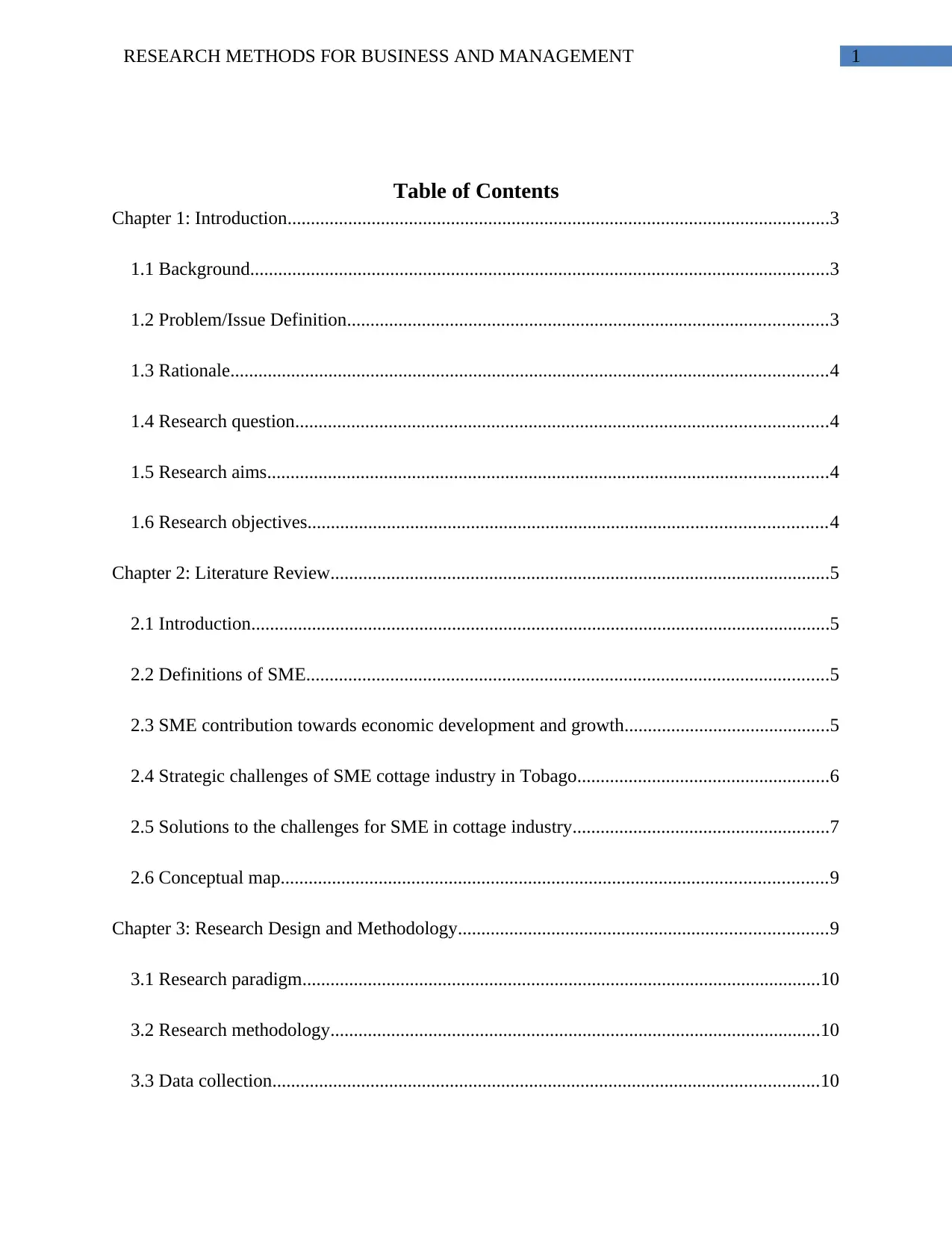
1RESEARCH METHODS FOR BUSINESS AND MANAGEMENT
Table of Contents
Chapter 1: Introduction....................................................................................................................3
1.1 Background............................................................................................................................3
1.2 Problem/Issue Definition.......................................................................................................3
1.3 Rationale................................................................................................................................4
1.4 Research question..................................................................................................................4
1.5 Research aims........................................................................................................................4
1.6 Research objectives...............................................................................................................4
Chapter 2: Literature Review...........................................................................................................5
2.1 Introduction............................................................................................................................5
2.2 Definitions of SME................................................................................................................5
2.3 SME contribution towards economic development and growth............................................5
2.4 Strategic challenges of SME cottage industry in Tobago......................................................6
2.5 Solutions to the challenges for SME in cottage industry.......................................................7
2.6 Conceptual map.....................................................................................................................9
Chapter 3: Research Design and Methodology...............................................................................9
3.1 Research paradigm...............................................................................................................10
3.2 Research methodology.........................................................................................................10
3.3 Data collection.....................................................................................................................10
Table of Contents
Chapter 1: Introduction....................................................................................................................3
1.1 Background............................................................................................................................3
1.2 Problem/Issue Definition.......................................................................................................3
1.3 Rationale................................................................................................................................4
1.4 Research question..................................................................................................................4
1.5 Research aims........................................................................................................................4
1.6 Research objectives...............................................................................................................4
Chapter 2: Literature Review...........................................................................................................5
2.1 Introduction............................................................................................................................5
2.2 Definitions of SME................................................................................................................5
2.3 SME contribution towards economic development and growth............................................5
2.4 Strategic challenges of SME cottage industry in Tobago......................................................6
2.5 Solutions to the challenges for SME in cottage industry.......................................................7
2.6 Conceptual map.....................................................................................................................9
Chapter 3: Research Design and Methodology...............................................................................9
3.1 Research paradigm...............................................................................................................10
3.2 Research methodology.........................................................................................................10
3.3 Data collection.....................................................................................................................10
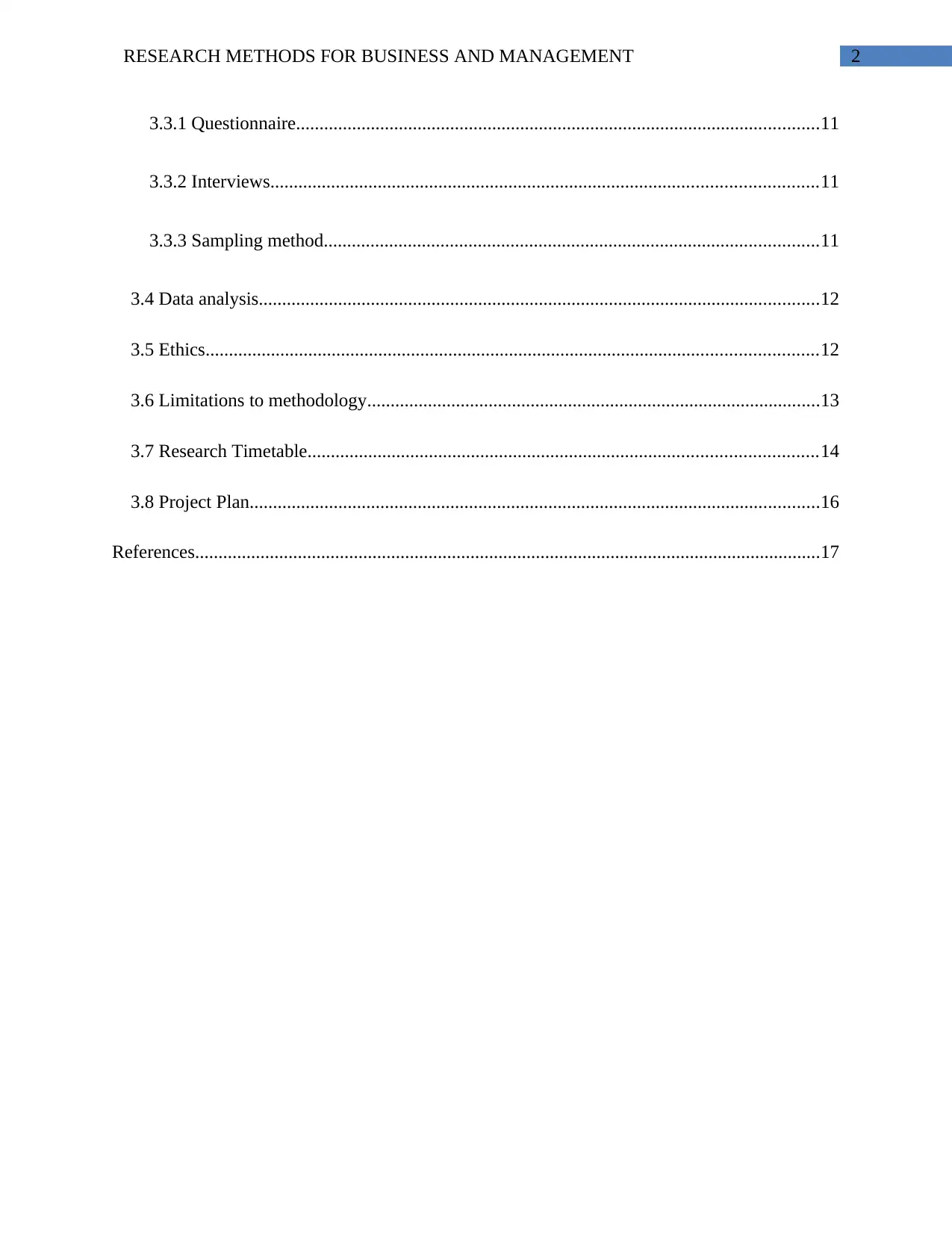
2RESEARCH METHODS FOR BUSINESS AND MANAGEMENT
3.3.1 Questionnaire................................................................................................................11
3.3.2 Interviews.....................................................................................................................11
3.3.3 Sampling method..........................................................................................................11
3.4 Data analysis........................................................................................................................12
3.5 Ethics...................................................................................................................................12
3.6 Limitations to methodology.................................................................................................13
3.7 Research Timetable.............................................................................................................14
3.8 Project Plan..........................................................................................................................16
References......................................................................................................................................17
3.3.1 Questionnaire................................................................................................................11
3.3.2 Interviews.....................................................................................................................11
3.3.3 Sampling method..........................................................................................................11
3.4 Data analysis........................................................................................................................12
3.5 Ethics...................................................................................................................................12
3.6 Limitations to methodology.................................................................................................13
3.7 Research Timetable.............................................................................................................14
3.8 Project Plan..........................................................................................................................16
References......................................................................................................................................17
⊘ This is a preview!⊘
Do you want full access?
Subscribe today to unlock all pages.

Trusted by 1+ million students worldwide
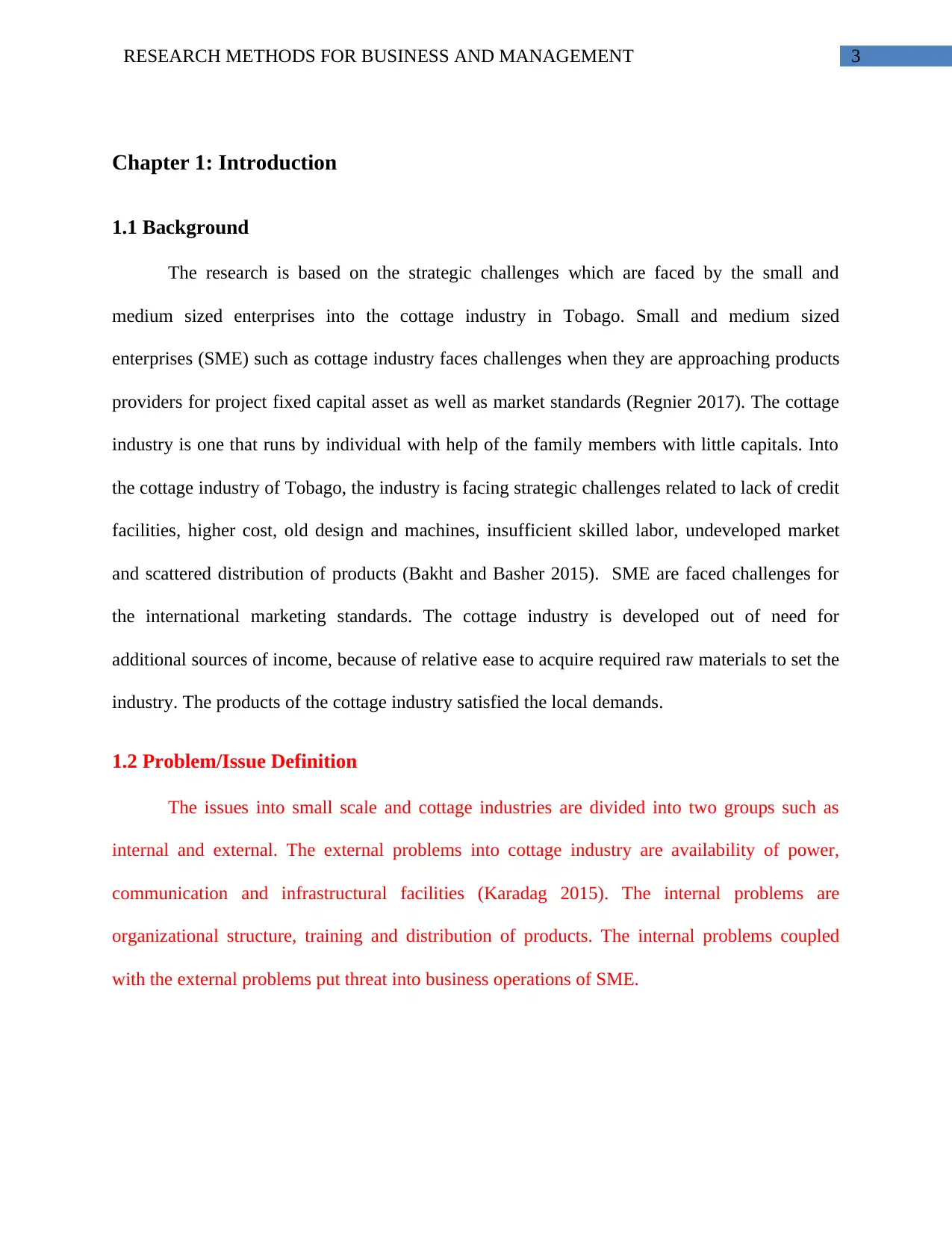
3RESEARCH METHODS FOR BUSINESS AND MANAGEMENT
Chapter 1: Introduction
1.1 Background
The research is based on the strategic challenges which are faced by the small and
medium sized enterprises into the cottage industry in Tobago. Small and medium sized
enterprises (SME) such as cottage industry faces challenges when they are approaching products
providers for project fixed capital asset as well as market standards (Regnier 2017). The cottage
industry is one that runs by individual with help of the family members with little capitals. Into
the cottage industry of Tobago, the industry is facing strategic challenges related to lack of credit
facilities, higher cost, old design and machines, insufficient skilled labor, undeveloped market
and scattered distribution of products (Bakht and Basher 2015). SME are faced challenges for
the international marketing standards. The cottage industry is developed out of need for
additional sources of income, because of relative ease to acquire required raw materials to set the
industry. The products of the cottage industry satisfied the local demands.
1.2 Problem/Issue Definition
The issues into small scale and cottage industries are divided into two groups such as
internal and external. The external problems into cottage industry are availability of power,
communication and infrastructural facilities (Karadag 2015). The internal problems are
organizational structure, training and distribution of products. The internal problems coupled
with the external problems put threat into business operations of SME.
Chapter 1: Introduction
1.1 Background
The research is based on the strategic challenges which are faced by the small and
medium sized enterprises into the cottage industry in Tobago. Small and medium sized
enterprises (SME) such as cottage industry faces challenges when they are approaching products
providers for project fixed capital asset as well as market standards (Regnier 2017). The cottage
industry is one that runs by individual with help of the family members with little capitals. Into
the cottage industry of Tobago, the industry is facing strategic challenges related to lack of credit
facilities, higher cost, old design and machines, insufficient skilled labor, undeveloped market
and scattered distribution of products (Bakht and Basher 2015). SME are faced challenges for
the international marketing standards. The cottage industry is developed out of need for
additional sources of income, because of relative ease to acquire required raw materials to set the
industry. The products of the cottage industry satisfied the local demands.
1.2 Problem/Issue Definition
The issues into small scale and cottage industries are divided into two groups such as
internal and external. The external problems into cottage industry are availability of power,
communication and infrastructural facilities (Karadag 2015). The internal problems are
organizational structure, training and distribution of products. The internal problems coupled
with the external problems put threat into business operations of SME.
Paraphrase This Document
Need a fresh take? Get an instant paraphrase of this document with our AI Paraphraser
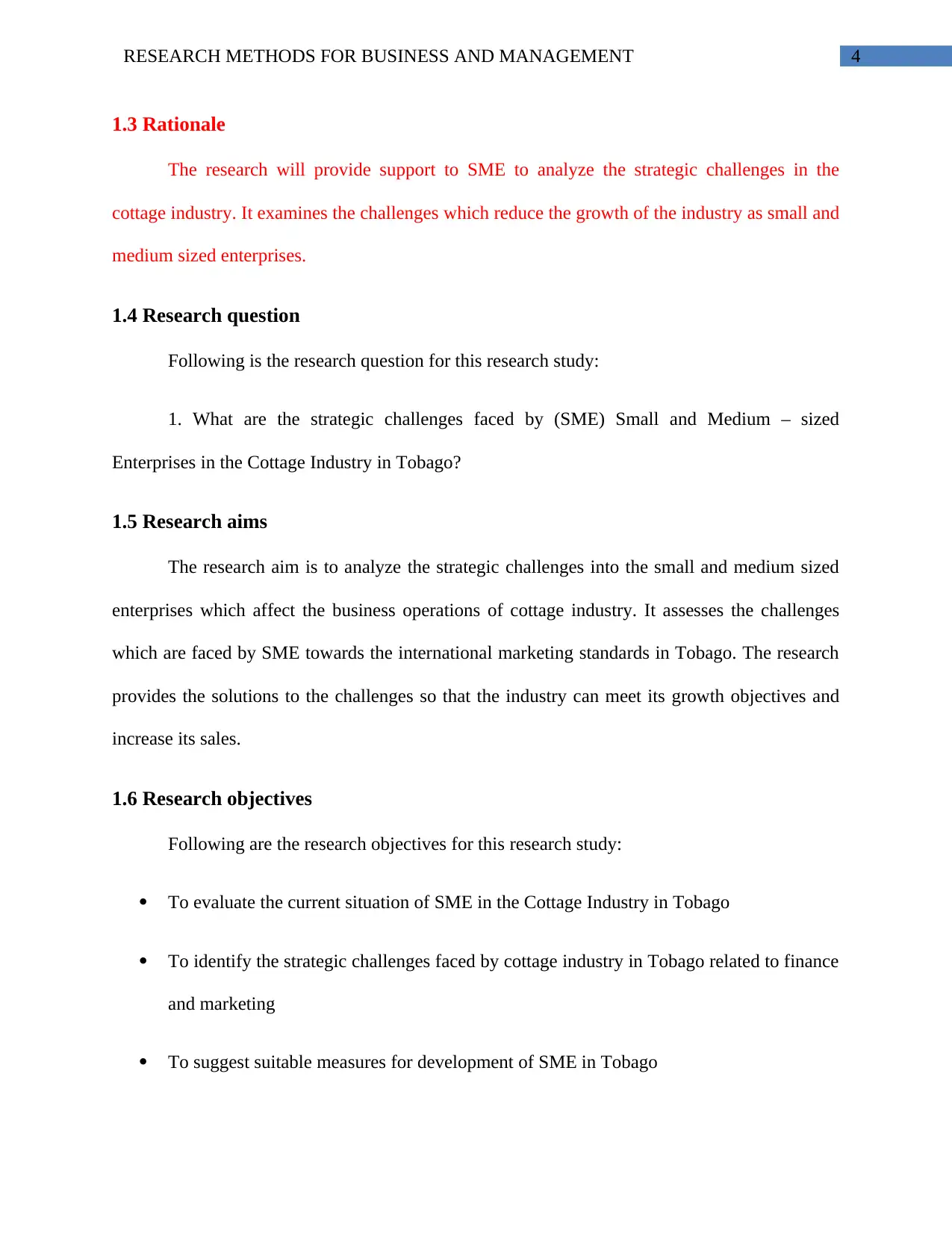
4RESEARCH METHODS FOR BUSINESS AND MANAGEMENT
1.3 Rationale
The research will provide support to SME to analyze the strategic challenges in the
cottage industry. It examines the challenges which reduce the growth of the industry as small and
medium sized enterprises.
1.4 Research question
Following is the research question for this research study:
1. What are the strategic challenges faced by (SME) Small and Medium – sized
Enterprises in the Cottage Industry in Tobago?
1.5 Research aims
The research aim is to analyze the strategic challenges into the small and medium sized
enterprises which affect the business operations of cottage industry. It assesses the challenges
which are faced by SME towards the international marketing standards in Tobago. The research
provides the solutions to the challenges so that the industry can meet its growth objectives and
increase its sales.
1.6 Research objectives
Following are the research objectives for this research study:
To evaluate the current situation of SME in the Cottage Industry in Tobago
To identify the strategic challenges faced by cottage industry in Tobago related to finance
and marketing
To suggest suitable measures for development of SME in Tobago
1.3 Rationale
The research will provide support to SME to analyze the strategic challenges in the
cottage industry. It examines the challenges which reduce the growth of the industry as small and
medium sized enterprises.
1.4 Research question
Following is the research question for this research study:
1. What are the strategic challenges faced by (SME) Small and Medium – sized
Enterprises in the Cottage Industry in Tobago?
1.5 Research aims
The research aim is to analyze the strategic challenges into the small and medium sized
enterprises which affect the business operations of cottage industry. It assesses the challenges
which are faced by SME towards the international marketing standards in Tobago. The research
provides the solutions to the challenges so that the industry can meet its growth objectives and
increase its sales.
1.6 Research objectives
Following are the research objectives for this research study:
To evaluate the current situation of SME in the Cottage Industry in Tobago
To identify the strategic challenges faced by cottage industry in Tobago related to finance
and marketing
To suggest suitable measures for development of SME in Tobago
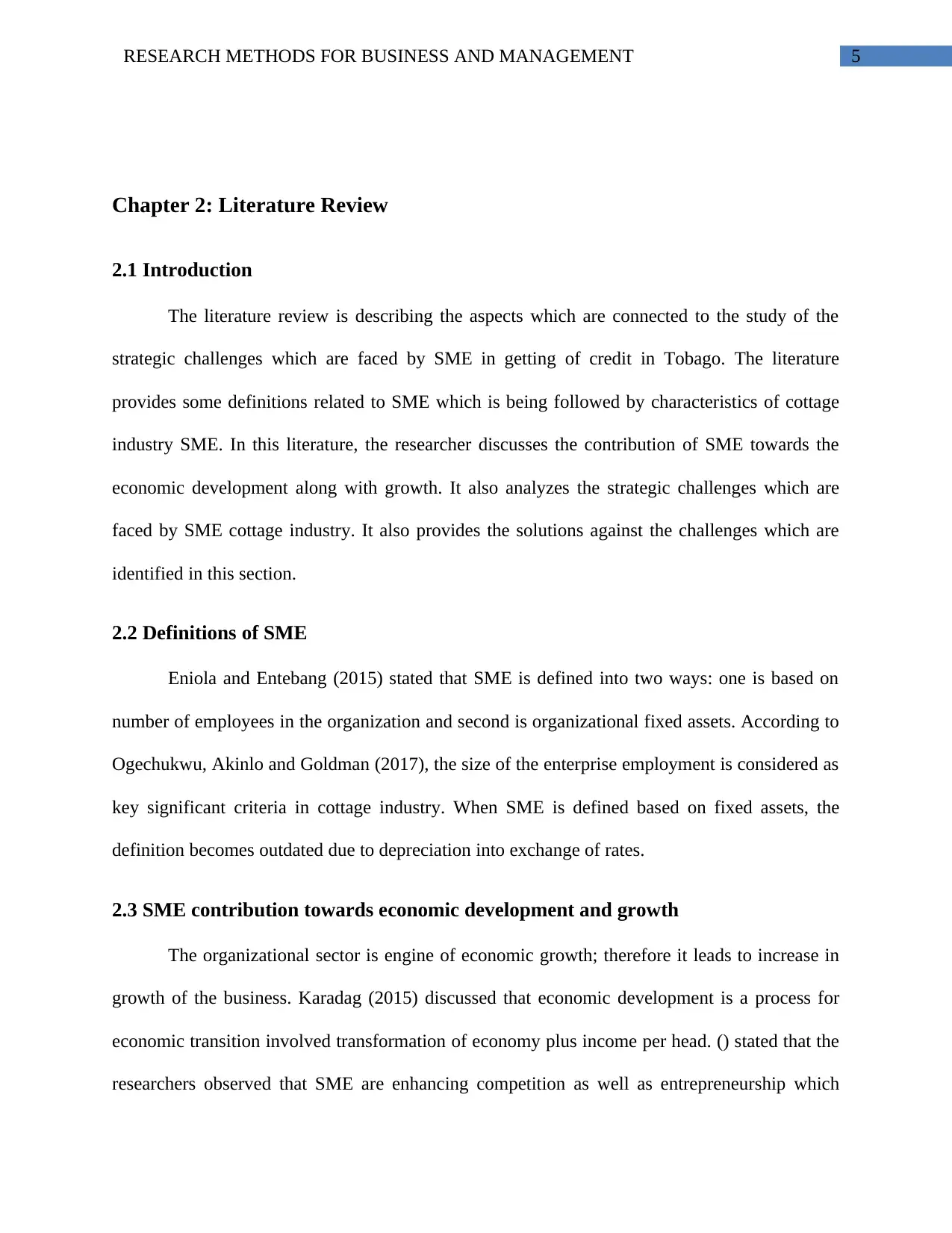
5RESEARCH METHODS FOR BUSINESS AND MANAGEMENT
Chapter 2: Literature Review
2.1 Introduction
The literature review is describing the aspects which are connected to the study of the
strategic challenges which are faced by SME in getting of credit in Tobago. The literature
provides some definitions related to SME which is being followed by characteristics of cottage
industry SME. In this literature, the researcher discusses the contribution of SME towards the
economic development along with growth. It also analyzes the strategic challenges which are
faced by SME cottage industry. It also provides the solutions against the challenges which are
identified in this section.
2.2 Definitions of SME
Eniola and Entebang (2015) stated that SME is defined into two ways: one is based on
number of employees in the organization and second is organizational fixed assets. According to
Ogechukwu, Akinlo and Goldman (2017), the size of the enterprise employment is considered as
key significant criteria in cottage industry. When SME is defined based on fixed assets, the
definition becomes outdated due to depreciation into exchange of rates.
2.3 SME contribution towards economic development and growth
The organizational sector is engine of economic growth; therefore it leads to increase in
growth of the business. Karadag (2015) discussed that economic development is a process for
economic transition involved transformation of economy plus income per head. () stated that the
researchers observed that SME are enhancing competition as well as entrepreneurship which
Chapter 2: Literature Review
2.1 Introduction
The literature review is describing the aspects which are connected to the study of the
strategic challenges which are faced by SME in getting of credit in Tobago. The literature
provides some definitions related to SME which is being followed by characteristics of cottage
industry SME. In this literature, the researcher discusses the contribution of SME towards the
economic development along with growth. It also analyzes the strategic challenges which are
faced by SME cottage industry. It also provides the solutions against the challenges which are
identified in this section.
2.2 Definitions of SME
Eniola and Entebang (2015) stated that SME is defined into two ways: one is based on
number of employees in the organization and second is organizational fixed assets. According to
Ogechukwu, Akinlo and Goldman (2017), the size of the enterprise employment is considered as
key significant criteria in cottage industry. When SME is defined based on fixed assets, the
definition becomes outdated due to depreciation into exchange of rates.
2.3 SME contribution towards economic development and growth
The organizational sector is engine of economic growth; therefore it leads to increase in
growth of the business. Karadag (2015) discussed that economic development is a process for
economic transition involved transformation of economy plus income per head. () stated that the
researchers observed that SME are enhancing competition as well as entrepreneurship which
⊘ This is a preview!⊘
Do you want full access?
Subscribe today to unlock all pages.

Trusted by 1+ million students worldwide
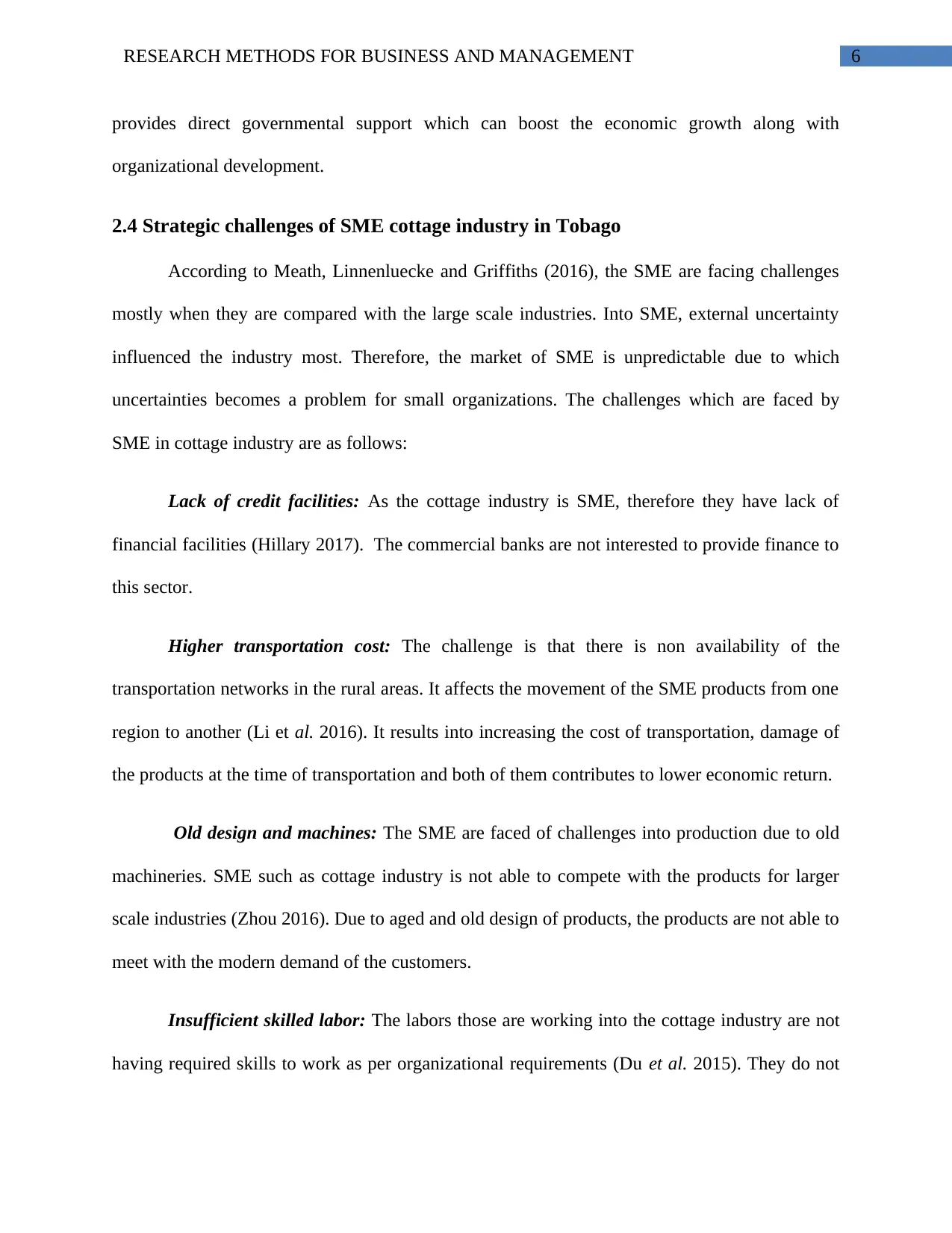
6RESEARCH METHODS FOR BUSINESS AND MANAGEMENT
provides direct governmental support which can boost the economic growth along with
organizational development.
2.4 Strategic challenges of SME cottage industry in Tobago
According to Meath, Linnenluecke and Griffiths (2016), the SME are facing challenges
mostly when they are compared with the large scale industries. Into SME, external uncertainty
influenced the industry most. Therefore, the market of SME is unpredictable due to which
uncertainties becomes a problem for small organizations. The challenges which are faced by
SME in cottage industry are as follows:
Lack of credit facilities: As the cottage industry is SME, therefore they have lack of
financial facilities (Hillary 2017). The commercial banks are not interested to provide finance to
this sector.
Higher transportation cost: The challenge is that there is non availability of the
transportation networks in the rural areas. It affects the movement of the SME products from one
region to another (Li et al. 2016). It results into increasing the cost of transportation, damage of
the products at the time of transportation and both of them contributes to lower economic return.
Old design and machines: The SME are faced of challenges into production due to old
machineries. SME such as cottage industry is not able to compete with the products for larger
scale industries (Zhou 2016). Due to aged and old design of products, the products are not able to
meet with the modern demand of the customers.
Insufficient skilled labor: The labors those are working into the cottage industry are not
having required skills to work as per organizational requirements (Du et al. 2015). They do not
provides direct governmental support which can boost the economic growth along with
organizational development.
2.4 Strategic challenges of SME cottage industry in Tobago
According to Meath, Linnenluecke and Griffiths (2016), the SME are facing challenges
mostly when they are compared with the large scale industries. Into SME, external uncertainty
influenced the industry most. Therefore, the market of SME is unpredictable due to which
uncertainties becomes a problem for small organizations. The challenges which are faced by
SME in cottage industry are as follows:
Lack of credit facilities: As the cottage industry is SME, therefore they have lack of
financial facilities (Hillary 2017). The commercial banks are not interested to provide finance to
this sector.
Higher transportation cost: The challenge is that there is non availability of the
transportation networks in the rural areas. It affects the movement of the SME products from one
region to another (Li et al. 2016). It results into increasing the cost of transportation, damage of
the products at the time of transportation and both of them contributes to lower economic return.
Old design and machines: The SME are faced of challenges into production due to old
machineries. SME such as cottage industry is not able to compete with the products for larger
scale industries (Zhou 2016). Due to aged and old design of products, the products are not able to
meet with the modern demand of the customers.
Insufficient skilled labor: The labors those are working into the cottage industry are not
having required skills to work as per organizational requirements (Du et al. 2015). They do not
Paraphrase This Document
Need a fresh take? Get an instant paraphrase of this document with our AI Paraphraser
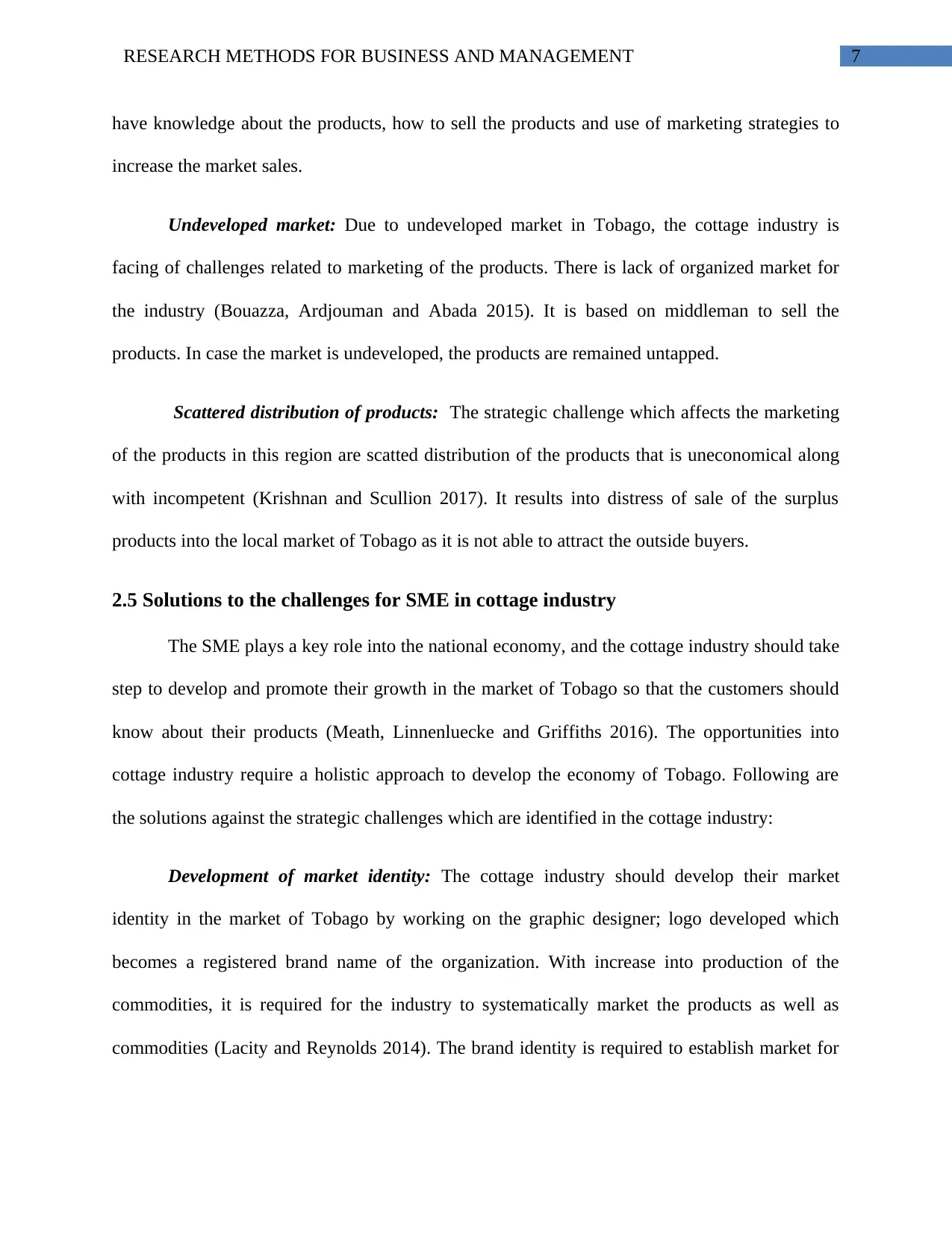
7RESEARCH METHODS FOR BUSINESS AND MANAGEMENT
have knowledge about the products, how to sell the products and use of marketing strategies to
increase the market sales.
Undeveloped market: Due to undeveloped market in Tobago, the cottage industry is
facing of challenges related to marketing of the products. There is lack of organized market for
the industry (Bouazza, Ardjouman and Abada 2015). It is based on middleman to sell the
products. In case the market is undeveloped, the products are remained untapped.
Scattered distribution of products: The strategic challenge which affects the marketing
of the products in this region are scatted distribution of the products that is uneconomical along
with incompetent (Krishnan and Scullion 2017). It results into distress of sale of the surplus
products into the local market of Tobago as it is not able to attract the outside buyers.
2.5 Solutions to the challenges for SME in cottage industry
The SME plays a key role into the national economy, and the cottage industry should take
step to develop and promote their growth in the market of Tobago so that the customers should
know about their products (Meath, Linnenluecke and Griffiths 2016). The opportunities into
cottage industry require a holistic approach to develop the economy of Tobago. Following are
the solutions against the strategic challenges which are identified in the cottage industry:
Development of market identity: The cottage industry should develop their market
identity in the market of Tobago by working on the graphic designer; logo developed which
becomes a registered brand name of the organization. With increase into production of the
commodities, it is required for the industry to systematically market the products as well as
commodities (Lacity and Reynolds 2014). The brand identity is required to establish market for
have knowledge about the products, how to sell the products and use of marketing strategies to
increase the market sales.
Undeveloped market: Due to undeveloped market in Tobago, the cottage industry is
facing of challenges related to marketing of the products. There is lack of organized market for
the industry (Bouazza, Ardjouman and Abada 2015). It is based on middleman to sell the
products. In case the market is undeveloped, the products are remained untapped.
Scattered distribution of products: The strategic challenge which affects the marketing
of the products in this region are scatted distribution of the products that is uneconomical along
with incompetent (Krishnan and Scullion 2017). It results into distress of sale of the surplus
products into the local market of Tobago as it is not able to attract the outside buyers.
2.5 Solutions to the challenges for SME in cottage industry
The SME plays a key role into the national economy, and the cottage industry should take
step to develop and promote their growth in the market of Tobago so that the customers should
know about their products (Meath, Linnenluecke and Griffiths 2016). The opportunities into
cottage industry require a holistic approach to develop the economy of Tobago. Following are
the solutions against the strategic challenges which are identified in the cottage industry:
Development of market identity: The cottage industry should develop their market
identity in the market of Tobago by working on the graphic designer; logo developed which
becomes a registered brand name of the organization. With increase into production of the
commodities, it is required for the industry to systematically market the products as well as
commodities (Lacity and Reynolds 2014). The brand identity is required to establish market for
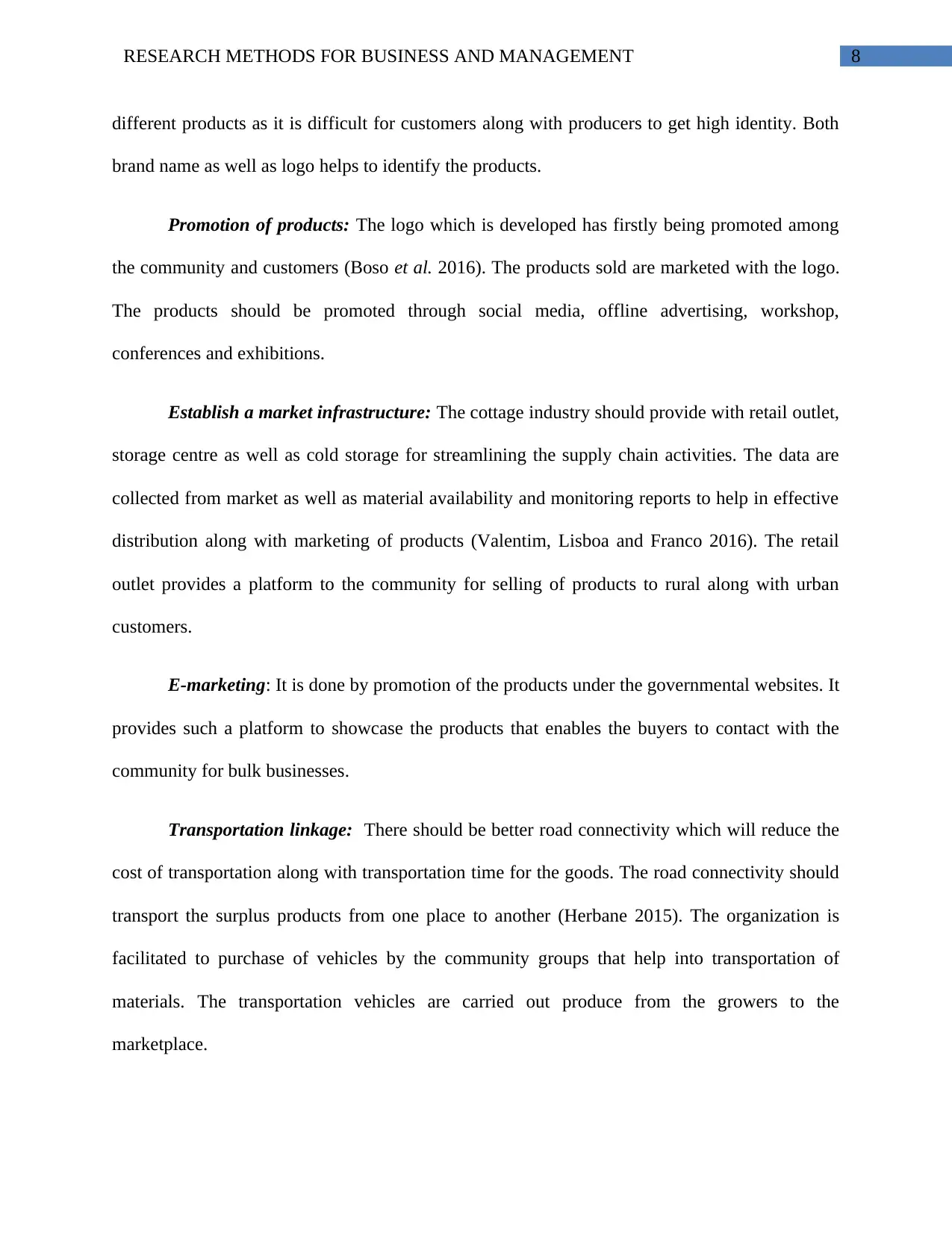
8RESEARCH METHODS FOR BUSINESS AND MANAGEMENT
different products as it is difficult for customers along with producers to get high identity. Both
brand name as well as logo helps to identify the products.
Promotion of products: The logo which is developed has firstly being promoted among
the community and customers (Boso et al. 2016). The products sold are marketed with the logo.
The products should be promoted through social media, offline advertising, workshop,
conferences and exhibitions.
Establish a market infrastructure: The cottage industry should provide with retail outlet,
storage centre as well as cold storage for streamlining the supply chain activities. The data are
collected from market as well as material availability and monitoring reports to help in effective
distribution along with marketing of products (Valentim, Lisboa and Franco 2016). The retail
outlet provides a platform to the community for selling of products to rural along with urban
customers.
E-marketing: It is done by promotion of the products under the governmental websites. It
provides such a platform to showcase the products that enables the buyers to contact with the
community for bulk businesses.
Transportation linkage: There should be better road connectivity which will reduce the
cost of transportation along with transportation time for the goods. The road connectivity should
transport the surplus products from one place to another (Herbane 2015). The organization is
facilitated to purchase of vehicles by the community groups that help into transportation of
materials. The transportation vehicles are carried out produce from the growers to the
marketplace.
different products as it is difficult for customers along with producers to get high identity. Both
brand name as well as logo helps to identify the products.
Promotion of products: The logo which is developed has firstly being promoted among
the community and customers (Boso et al. 2016). The products sold are marketed with the logo.
The products should be promoted through social media, offline advertising, workshop,
conferences and exhibitions.
Establish a market infrastructure: The cottage industry should provide with retail outlet,
storage centre as well as cold storage for streamlining the supply chain activities. The data are
collected from market as well as material availability and monitoring reports to help in effective
distribution along with marketing of products (Valentim, Lisboa and Franco 2016). The retail
outlet provides a platform to the community for selling of products to rural along with urban
customers.
E-marketing: It is done by promotion of the products under the governmental websites. It
provides such a platform to showcase the products that enables the buyers to contact with the
community for bulk businesses.
Transportation linkage: There should be better road connectivity which will reduce the
cost of transportation along with transportation time for the goods. The road connectivity should
transport the surplus products from one place to another (Herbane 2015). The organization is
facilitated to purchase of vehicles by the community groups that help into transportation of
materials. The transportation vehicles are carried out produce from the growers to the
marketplace.
⊘ This is a preview!⊘
Do you want full access?
Subscribe today to unlock all pages.

Trusted by 1+ million students worldwide
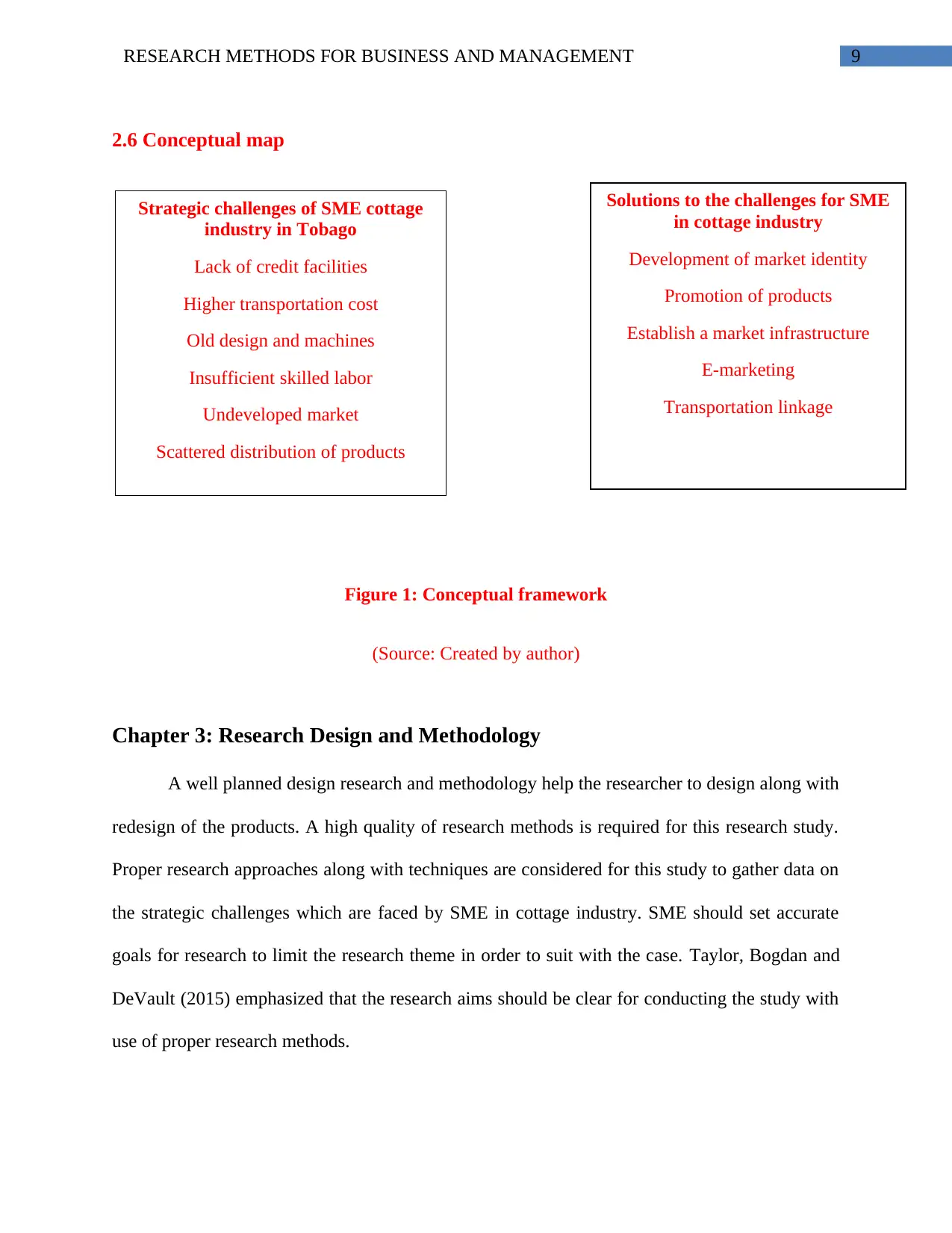
9RESEARCH METHODS FOR BUSINESS AND MANAGEMENT
2.6 Conceptual map
Figure 1: Conceptual framework
(Source: Created by author)
Chapter 3: Research Design and Methodology
A well planned design research and methodology help the researcher to design along with
redesign of the products. A high quality of research methods is required for this research study.
Proper research approaches along with techniques are considered for this study to gather data on
the strategic challenges which are faced by SME in cottage industry. SME should set accurate
goals for research to limit the research theme in order to suit with the case. Taylor, Bogdan and
DeVault (2015) emphasized that the research aims should be clear for conducting the study with
use of proper research methods.
Strategic challenges of SME cottage
industry in Tobago
Lack of credit facilities
Higher transportation cost
Old design and machines
Insufficient skilled labor
Undeveloped market
Scattered distribution of products
Solutions to the challenges for SME
in cottage industry
Development of market identity
Promotion of products
Establish a market infrastructure
E-marketing
Transportation linkage
2.6 Conceptual map
Figure 1: Conceptual framework
(Source: Created by author)
Chapter 3: Research Design and Methodology
A well planned design research and methodology help the researcher to design along with
redesign of the products. A high quality of research methods is required for this research study.
Proper research approaches along with techniques are considered for this study to gather data on
the strategic challenges which are faced by SME in cottage industry. SME should set accurate
goals for research to limit the research theme in order to suit with the case. Taylor, Bogdan and
DeVault (2015) emphasized that the research aims should be clear for conducting the study with
use of proper research methods.
Strategic challenges of SME cottage
industry in Tobago
Lack of credit facilities
Higher transportation cost
Old design and machines
Insufficient skilled labor
Undeveloped market
Scattered distribution of products
Solutions to the challenges for SME
in cottage industry
Development of market identity
Promotion of products
Establish a market infrastructure
E-marketing
Transportation linkage
Paraphrase This Document
Need a fresh take? Get an instant paraphrase of this document with our AI Paraphraser
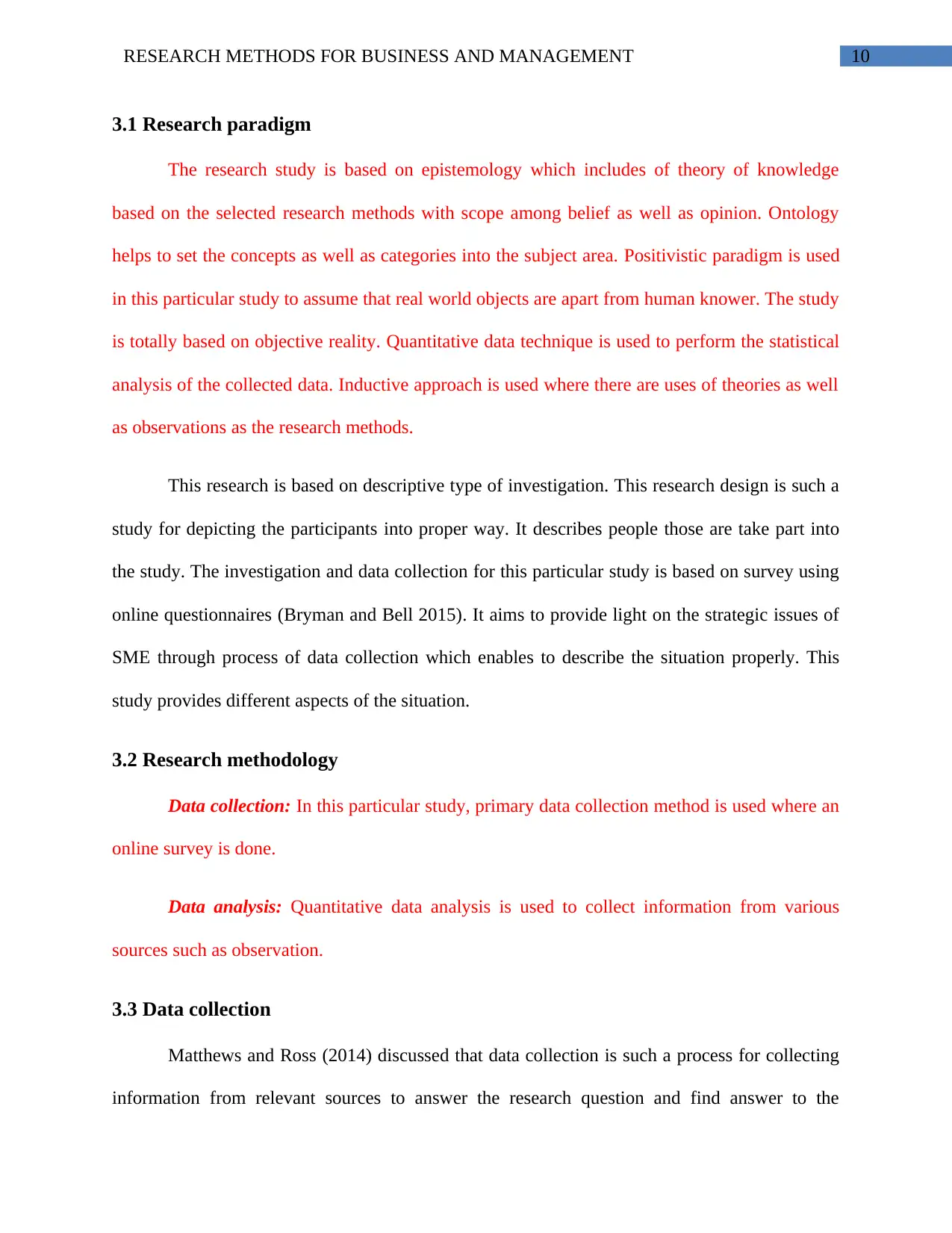
10RESEARCH METHODS FOR BUSINESS AND MANAGEMENT
3.1 Research paradigm
The research study is based on epistemology which includes of theory of knowledge
based on the selected research methods with scope among belief as well as opinion. Ontology
helps to set the concepts as well as categories into the subject area. Positivistic paradigm is used
in this particular study to assume that real world objects are apart from human knower. The study
is totally based on objective reality. Quantitative data technique is used to perform the statistical
analysis of the collected data. Inductive approach is used where there are uses of theories as well
as observations as the research methods.
This research is based on descriptive type of investigation. This research design is such a
study for depicting the participants into proper way. It describes people those are take part into
the study. The investigation and data collection for this particular study is based on survey using
online questionnaires (Bryman and Bell 2015). It aims to provide light on the strategic issues of
SME through process of data collection which enables to describe the situation properly. This
study provides different aspects of the situation.
3.2 Research methodology
Data collection: In this particular study, primary data collection method is used where an
online survey is done.
Data analysis: Quantitative data analysis is used to collect information from various
sources such as observation.
3.3 Data collection
Matthews and Ross (2014) discussed that data collection is such a process for collecting
information from relevant sources to answer the research question and find answer to the
3.1 Research paradigm
The research study is based on epistemology which includes of theory of knowledge
based on the selected research methods with scope among belief as well as opinion. Ontology
helps to set the concepts as well as categories into the subject area. Positivistic paradigm is used
in this particular study to assume that real world objects are apart from human knower. The study
is totally based on objective reality. Quantitative data technique is used to perform the statistical
analysis of the collected data. Inductive approach is used where there are uses of theories as well
as observations as the research methods.
This research is based on descriptive type of investigation. This research design is such a
study for depicting the participants into proper way. It describes people those are take part into
the study. The investigation and data collection for this particular study is based on survey using
online questionnaires (Bryman and Bell 2015). It aims to provide light on the strategic issues of
SME through process of data collection which enables to describe the situation properly. This
study provides different aspects of the situation.
3.2 Research methodology
Data collection: In this particular study, primary data collection method is used where an
online survey is done.
Data analysis: Quantitative data analysis is used to collect information from various
sources such as observation.
3.3 Data collection
Matthews and Ross (2014) discussed that data collection is such a process for collecting
information from relevant sources to answer the research question and find answer to the
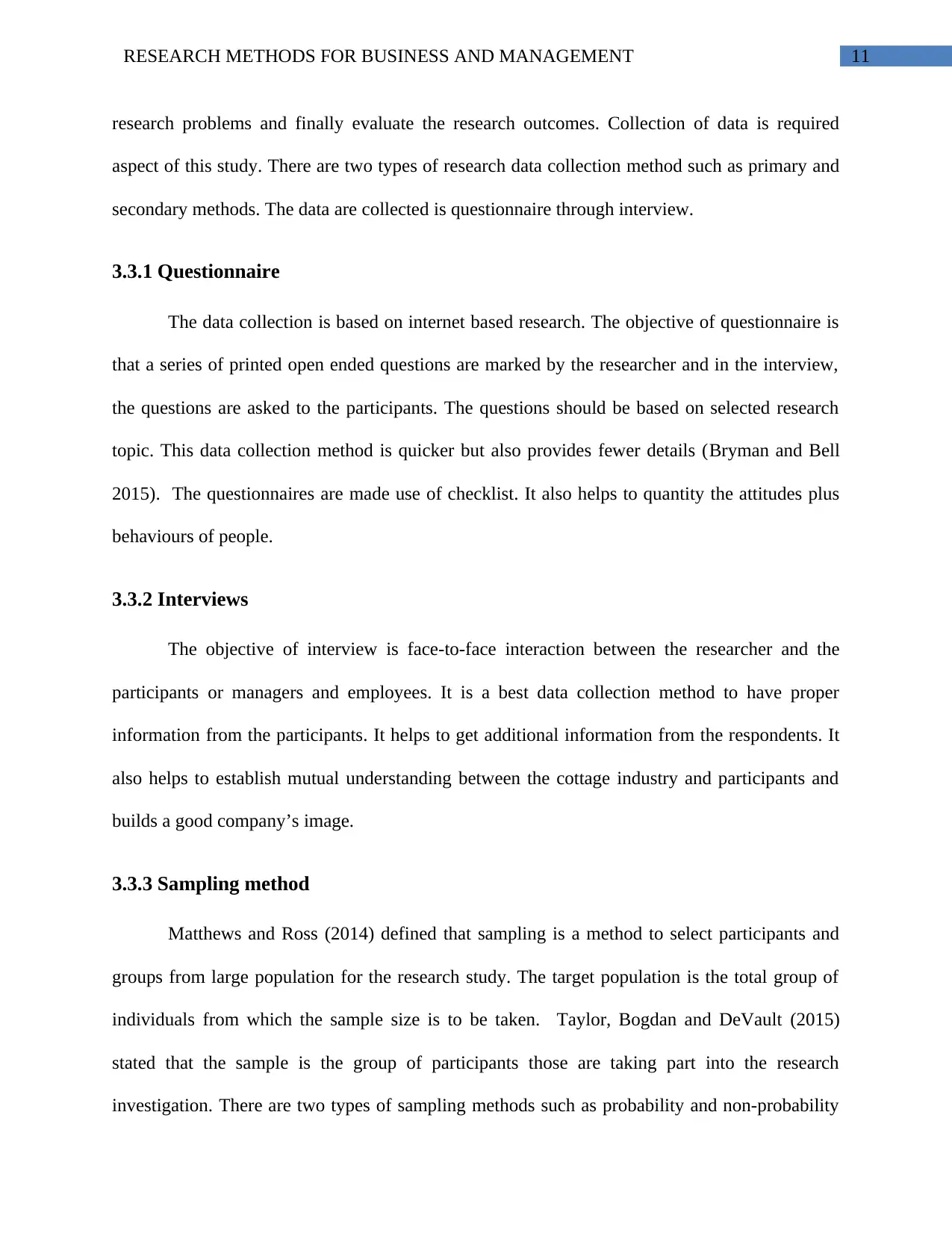
11RESEARCH METHODS FOR BUSINESS AND MANAGEMENT
research problems and finally evaluate the research outcomes. Collection of data is required
aspect of this study. There are two types of research data collection method such as primary and
secondary methods. The data are collected is questionnaire through interview.
3.3.1 Questionnaire
The data collection is based on internet based research. The objective of questionnaire is
that a series of printed open ended questions are marked by the researcher and in the interview,
the questions are asked to the participants. The questions should be based on selected research
topic. This data collection method is quicker but also provides fewer details (Bryman and Bell
2015). The questionnaires are made use of checklist. It also helps to quantity the attitudes plus
behaviours of people.
3.3.2 Interviews
The objective of interview is face-to-face interaction between the researcher and the
participants or managers and employees. It is a best data collection method to have proper
information from the participants. It helps to get additional information from the respondents. It
also helps to establish mutual understanding between the cottage industry and participants and
builds a good company’s image.
3.3.3 Sampling method
Matthews and Ross (2014) defined that sampling is a method to select participants and
groups from large population for the research study. The target population is the total group of
individuals from which the sample size is to be taken. Taylor, Bogdan and DeVault (2015)
stated that the sample is the group of participants those are taking part into the research
investigation. There are two types of sampling methods such as probability and non-probability
research problems and finally evaluate the research outcomes. Collection of data is required
aspect of this study. There are two types of research data collection method such as primary and
secondary methods. The data are collected is questionnaire through interview.
3.3.1 Questionnaire
The data collection is based on internet based research. The objective of questionnaire is
that a series of printed open ended questions are marked by the researcher and in the interview,
the questions are asked to the participants. The questions should be based on selected research
topic. This data collection method is quicker but also provides fewer details (Bryman and Bell
2015). The questionnaires are made use of checklist. It also helps to quantity the attitudes plus
behaviours of people.
3.3.2 Interviews
The objective of interview is face-to-face interaction between the researcher and the
participants or managers and employees. It is a best data collection method to have proper
information from the participants. It helps to get additional information from the respondents. It
also helps to establish mutual understanding between the cottage industry and participants and
builds a good company’s image.
3.3.3 Sampling method
Matthews and Ross (2014) defined that sampling is a method to select participants and
groups from large population for the research study. The target population is the total group of
individuals from which the sample size is to be taken. Taylor, Bogdan and DeVault (2015)
stated that the sample is the group of participants those are taking part into the research
investigation. There are two types of sampling methods such as probability and non-probability
⊘ This is a preview!⊘
Do you want full access?
Subscribe today to unlock all pages.

Trusted by 1+ million students worldwide
1 out of 20
Related Documents
Your All-in-One AI-Powered Toolkit for Academic Success.
+13062052269
info@desklib.com
Available 24*7 on WhatsApp / Email
![[object Object]](/_next/static/media/star-bottom.7253800d.svg)
Unlock your academic potential
Copyright © 2020–2025 A2Z Services. All Rights Reserved. Developed and managed by ZUCOL.





